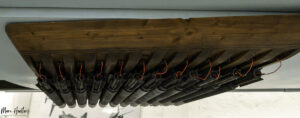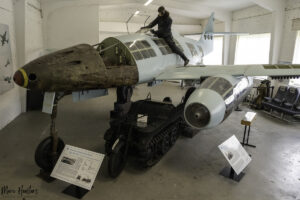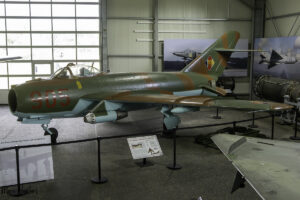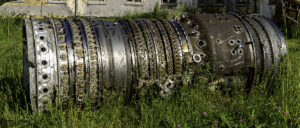
Müritz Airpark (IATA: REB, ICAO: EDAX), previously known as Rechlin–Lärz Airfield is an airfield in the village of Rechlin, Mecklenburg-Western Pomerania, Germany.




The airport was once part of the Third Reich era’s Luftwaffe main testing ground, or Erprobungsstelle for new aircraft designs, the heart of which was actually centered on two large turf areas some 4.5 km (2.8 mi) due north of the 21st century era paved-runway airport facility. The core airfield of the Luftwaffe facility took the form of a typical pre-World War II aerodrome, with no clearly defined “runways”, being bounded by a roughly hexagonal-layout perimeter road that still exists today, defining an area approximately 1,700 meters (5,600 feet) across. Four large groups of buildings were built around the almost round grass square, the North (administration, laboratories), South (engine testing), East (ammunition, weapons) and West (technical company, barracks) groups.








On 26 February 1935, Reichswehr Minister Blomberg ordered the gradual unmasking of the Luftwaffe and Rechlin finally became the “Luftwaffe Test Centre” as a branch office of the Technical Office of the Reich Ministry of Aviation in Berlin. The activities were part of “official supervision”. Their aim was to determine the usability of aircraft and equipment. In addition, type tests were also carried out on new aircraft types. Examples of test tasks were the achievement of the required speeds, range, maximum altitude, strength, stability and controllability. Maintenance, ergonomics, ease of repair and other aspects that had an impact on the later use of the device by the troops were also examined. In 1939, tests were carried out with the world’s first jet aircraft (Heinkel He 178), and from 1940 also with Heinkel He 280, but initially without engines (tow flights with He 111).








These investigations repeatedly led to developments that eventually found their way into aviation technology and significantly improved the corresponding equipment. These included, for example, various types of parachutes (including ribbon parachutes), thumb switches, automatic course controls (autopilot), special instrumentation, sea rescue with fixed-wing aircraft, the Rechliner cold start procedure and procedures for short-term increases in the altitude performance of aircraft engines. On July 3, 1939, the first rocket-powered aircraft was demonstrated. During the testing of the twin-engine jet aircraft Heinkel He 280 V1 (DL+AS) on January 13, 1943, the first ejection seat committee in aviation history took place. For example, the tests of Department F resulted in numerous innovations in radio technology. Many specialists in these and other departments were taken over by the Allies after the end of the war.





In addition to the purely technical testing of all land aircraft and their accessories, new aircraft were examined for their military usefulness, especially after the beginning of the war. For this purpose, the “Lärz Test Commando” was set up, which was normally assigned the so-called pre-series or pilot series samples for operational testing. From mid-1944, the testing of the new jet aircraft Me 262, Ar 234 and He 162 became a top priority.














Many of the Luftwaffe’s new combat aircraft prototypes were test flown at the main turf-fielded Rechlin facilities; the special operations combat wing of the Luftwaffe, KG 200, with its array of captured planes was a regular guest at the airfields. After several Allied bombing runs on the primary turf-surfaced aerodrome field of Rechlin, and the satellite Roggentin airfield in 1944, testing of late-war planes was shifted just southwards to Lärz.
In 1946, the Soviet Air Force established a permanent presence at the airbase. The 19th Guards fighter-bomber regiment of the 16th Air Army and a helicopter squadron were stationed at Lärz; the airfield at Rechlin was used by the National People’s Army (NVA). Military usage of the airfields continued until 1993, when the last Russian air force units were moved home. The Rechlin airfield was reopened for civilian use in 1994.






